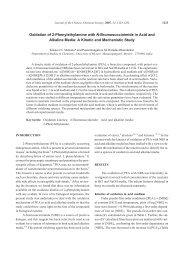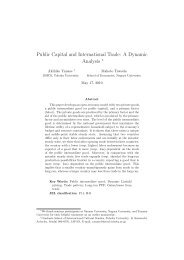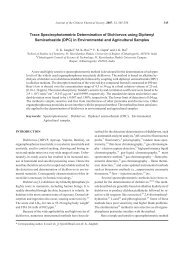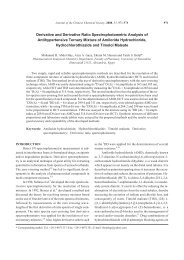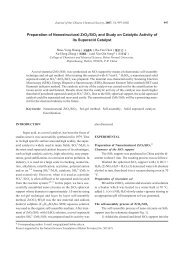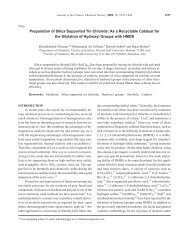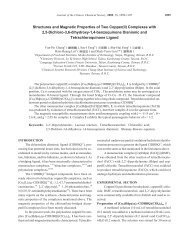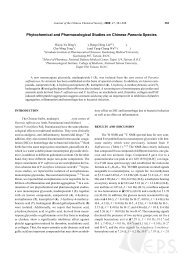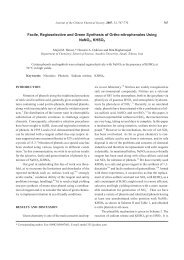Biotinylation of Peptides/Proteins using Biocytin Hydrazide
Biotinylation of Peptides/Proteins using Biocytin Hydrazide
Biotinylation of Peptides/Proteins using Biocytin Hydrazide
Create successful ePaper yourself
Turn your PDF publications into a flip-book with our unique Google optimized e-Paper software.
<strong>Biotinylation</strong> <strong>of</strong> <strong>Peptides</strong>/<strong>Proteins</strong> <strong>using</strong> <strong>Biocytin</strong> <strong>Hydrazide</strong> J. Chin. Chem. Soc., Vol. 54, No. 2, 2007 547<br />
insulin and BSA <strong>using</strong> 1 M biocytin hydrazide at 65 C. It is<br />
noted that the influence <strong>of</strong> pH on the biotinylation efficiency<br />
<strong>of</strong> peptides/proteins is less pronounced. The reaction<br />
times were 24 h and 5 h for insulin and BSA, respectively.<br />
With the 10% (v/v) aqueous TFA (pKa 0.5) as the<br />
solvent, up to 12 biotinylations for BSA and up to five<br />
biotinylations for insulin are observed. With PBS (pH 7.4)<br />
as the solvent, an average <strong>of</strong> 17 biotinylations for BSA and<br />
up to seven biotinylations for insulin are observed. With 50<br />
mM Na2CO3 (pH 10) as the solvent, there are an average <strong>of</strong><br />
6.6 biotinylations for BSA and up to four biotinylations for<br />
insulin. Data shows that neutral pH is perhaps the optimum<br />
for biotinylation <strong>of</strong> peptides/proteins <strong>using</strong> biocytin hydrazide.<br />
Fig. 8 shows the MALDI-PSD TOF spectrum <strong>of</strong> biotinylated<br />
P14Ratm/z 1904. Biotinylated P14R was produced<br />
by reacting with 1 M biocytin hydrazide at 65 C for 24 h.<br />
10% TFA aqueous solution (v/v) was used as the solvent.<br />
Data displays “y” (bond-cleavage fragments that retain<br />
C-terminal side <strong>of</strong> the peptide) fragment ions. The detected<br />
y11 (m/z 1519), y12 (m/z 1613), y13 (m/z 1710), and y14 (m/z<br />
1807) fragment ions are in agreement with the m/z values <strong>of</strong><br />
the fragments carrying a biocytin hydrazide, indicating that<br />
the biocytin hydrazide is attached to the arginine side chain<br />
<strong>of</strong> the peptide because if biocytin hydrazide is attached to<br />
the proline residue, one would observe many multiply biotinylated<br />
P14R. It is noted that PSD results (data not shown)<br />
<strong>of</strong> ACTH and angiotensin I show that the arginine side<br />
chain for both peptides is biotinylated.<br />
Fig. 8. The MALDI-PSD TOF spectrum <strong>of</strong> biotinylated<br />
P14R. Biotinylated P14R was produced by<br />
reacting with 1 M biocytin hydrazide at 65 C<br />
for 24 h. 10% TFA (v/v) aqueous solution was<br />
used as the solvent. Peptide solution (1 g/l)<br />
was processed with Zip-Tip before MALDI-<br />
TOF MS.<br />
CONCLUSIONS<br />
MALDI-TOF Mass Spectrometry has been successfully<br />
used to investigate the biotinylation <strong>of</strong> peptides/proteins<br />
<strong>using</strong> biocytin hydrazide. Besides the physiological<br />
conditions, harsh conditions (65 C; higher concentration<br />
<strong>of</strong> biocytin hydrazide; higher and lower pH; longer reaction<br />
time) are also used in this study. Results indicate that biotinylation<br />
<strong>of</strong> peptides/proteins is readily accomplished with<br />
biocytin hydrazide. The efficiency <strong>of</strong> the biotinylation reaction<br />
increases with higher temperature, higher biocytin<br />
hydrazide concentration, or longer reaction time. The influence<br />
<strong>of</strong> buffer pH on the biotinylation reaction <strong>of</strong> peptides/<br />
proteins is less pronounced. The biotinylation efficiency is<br />
optimum at neutral pH. Post-source decay data <strong>of</strong> biotinylated<br />
P14R, ACTH, and angiotensin I indicate that biocytin<br />
hydrazide reacts with the guanidino group present on the<br />
side chain <strong>of</strong> the arginine residue. Since the peptides/proteins<br />
react with biocytin hydrazide, 2-iminobiotin hydrazide,<br />
adipic dihydrazide and phenyl hydrazine but not with<br />
biocytin HCl and 2-iminobiotin, the biotinylation reaction<br />
<strong>of</strong> peptides/proteins should occur with the hydrazide moiety<br />
but not with biotin moiety <strong>of</strong> the biotinylated reagent. In<br />
short, this study shows that biocytin hydrazide can react<br />
readily with peptides/proteins through the amino and/or<br />
guanidino groups. Caution should be exercised when biotinylating<br />
the carbohydrate moiety <strong>of</strong> iodate-oxidized glycoproteins<br />
<strong>using</strong> biocytin hydrazide to alleviate this side reaction.<br />
ACKNOWLEDGEMENTS<br />
We thank the Research Resources Center at the University<br />
<strong>of</strong> Illinois at Chicago for their support.<br />
Received April 10, 2006.<br />
REFERENCES<br />
1. Wilchek, M.; Bayer, E. A., Eds. Avidin-Biotin Technology;<br />
Academic Press: San Diego, CA, 1990.<br />
2. Hermanson, G. T. Bioconjugate Techniques; Academic<br />
Press: San Diego, CA, 1996.<br />
3. Bayer, E. A.; Ben-Hur, H.; Wilchek, M. Anal. Biochem.<br />
1988, 170, 271.



